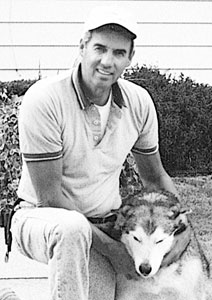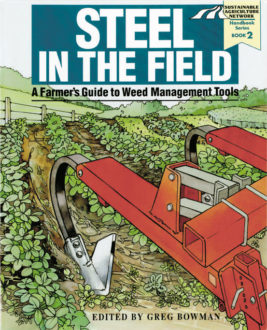
Agronomic Row Crops: The Farmers
A Sustainable Transition Takes the Right Metal
Jack Erisman
Pana, Illinois
- 1,800 acres (all certified organic)
- 80-cow, cow/calf beef herd
- legumes: sweet clover, red clover, alfalfa
- row crops: corn, edible soybeans
- orchardgrass/clover/alfalfa pasture mix
- mulch tillage with disking
- cover crops: rye, buckwheat, hairy vetch
- small grains: oats, wheat, canola, rye, triticale
Weed management highlights
Strategies: Minimum tillage... cover crops... seven-year, flexible crop rotation... mechanical cultivation
Tools: Flexible-chain harrow... high-residue rotary hoe... three cultivators (low-residue, high-residue, maximum residue)... heavy and light tandem disks
Jack Erisman uses both conventional and unconventional practices to protect his soil resources and production potential. Terraces he built long ago now seem less important to him than thick-rooted cover crops for erosion control. He has a wide inventory of tillage and cultivation tools not because he likes to use them, but so he can use each one as little as possible to its best advantage.
Building his soil's biological quality and its loose, crumbly structure are his primary goals and serve as the foundation for successful integrated systems of non-chemical weed control and crop production. His on-farm research is geared to finding the tillage-cutting building blocks of organic, no-till systems for soybeans and other cash crops.
Erisman has been practicing conservation tillage for more than 25 years, having used a modified ridge-till system in the late '60s and early '70s. He began testing organic management methods in '88 and quit using synthetic fertilizers and herbicides in '90.
He's kept his farming herbicide-free since then and completely organic since '93. He credits a flexible rotation for part of his success. For a typical seven-year rotation he plants an overwintering rye cover crop followed by soybeans; a fall-planted small grain; a legume/grass mix 'frost-seeded' into the grain in late winter; several years of hay or pasture; corn; another rye cover-soybeans sequence; cereal grain frost-seeded with a legume/grass mix; finishing with a fallow year when the forage mix growth is clipped but left to replenish soil organic matter.
The seventh year's 'crop' is enrichment and regeneration of soil biological life. Erisman calculates that the soil benefits which improve and protect succeeding crops easily offset his opportunity cost plus clipping and $20 per acre in taxes. A late seeding of buckwheat for grain in the seventh summer and then a fall seeding of rye to restart the rotation combine to provide a needed break in the legume cycle that prevents a buildup of soil disease organisms.
To fit fields and control weeds for his broad crop mix, Erisman has an array of cultivation equipment.
He likes how his M&W Gear high-residue rotary hoe's single wheel-per-arm design provides enough weight and downward pressure to aggressively expose weed seedlings, for example. 'A double toolbar hoe can seem smoother, but you'd need more springs and bearings in crusty settings,' he observes. Soil crusting isn't the norm in Erisman's silty clay loam fields.
He usually hoes at least once and up to three times if warranted, at speeds from 5 to 10 mph, depending on soil conditions. Often, he'll double back so that wheels work different areas. 'You could cover more ground faster with a double-toolbar hoe and save fuel. But I think I get more aggressive action by lapping back. To concentrate the best weed control where it's needed most for a modest cost, Erisman replaces hoe wheels over the row more often than those that run between the rows, where his cultivator will clean up the survivors.
His heavy-duty, 8-row Buffalo 6300 maximum-residue cultivator handles field residue without any trouble and adjusts easily for different conditions. On first cultivation of soybeans, Erisman usually turns disk hillers to throw soil into row middles and spaces them 7 inches apart, then reverses them for the next cultivation. He travels 7 to 8 mph with the Buffalo for each cultivation, using big 24-inch one-piece sweeps on 36-inch rows, typically operating 1.5 to 2 inches deep or deeper, depending on the mulch.
'One disadvantage of the Buffalo is its weight. But that also stabilizes it well,' says Erisman. He went to a heavier tractor with improved hydraulics and rarely counterbalances the front with more than a thousand pounds.
- To avoid soil compaction in mellow fields, he uses a lighter, compact Orthman Super Sweep high-residue cultivator for second or third cultivations when he can. The wide point-and-share sweeps clean out row middles nicely in late season if wet or dry conditions have encouraged weeds. 'The different share sizes let me adjust clearances pretty easily and I run it without front disks or shields.'
- In low-residue situations - typically fields where cattle have grazed - Erisman uses an old International 153 low-residue cultivator with multiple 8- to 10-inch sweeps and straight shanks. He runs it at about 4 mph at a depth of 1 to 1.5 inches about 7 inches from the row for first cultivation of soybeans, using panel shields to protect crops. He occasionally uses it for second cultivation, when he just takes off shields and speeds up to 6 to 7 mph. He adjusts the sweep pitch from flat up to 2 inches, depending on how much soil he wants to throw and how worn the sweeps are.
Erisman waits for corn or bean plants to be at least 4 inches tall before he cultivates, but he also evaluates plant stability. Spindly plants that have developed in cool, wet weather need to be taller to withstand even slight soil movement, he says.
A coil-tine harrow would be even better than the 32-foot Fuerst flexible-chain harrow Erisman relies on, but they're hard to find in his area, he says. Depending on soil conditions and planting depth, he typically harrows beans the third day after planting, at anywhere from 5 to 8 mph and a depth of a quarter- to a half-inch. The harrow works best in his loose soils where its fixed points cause rapid surface turbulence that disrupts weeds. The rotary hoe, by contrast, works best in his fields with tighter or crusted soils where its arms shatter soil and fling out weeds.
Wants Fewer Passes
Erisman's shift to organic crop production systems increases overall tillage due to crop rotation and mechanical cultivation. Rather than an adverse impact on the soil, he's seen changes for the better. 'Green manure crops cushion the tillage impact,' he says. 'Our soil structure has improved - it's more granular and friable than it was.'
Hand digging and visual observations by researchers from the USDA National Soil Tilth Lab showed significant differences in soil tilth structure on his farm compared with neighboring farms. Erisman credits the distinction partly to his use of deep-penetrating legumes, such as alfalfa and sweetclovers, and minimal use of deep tillage.
Erisman has fields in different stages of organic transition and many crop sequences to juggle. Critical management situations include
Rye to soybeans. His main rye-killing tool is a John Deere 32-foot offset disk. In wet years, he starts with a flail mower to stop growth and buy time until field conditions permit disking. Final preplant weed control and soil conditioning comes from his 36-foot Field Cultivator. Rye requires careful management to coax out all its benefits. 'Rye residue can keep ground cold, and its allelopathic (weed suppressing) effects are gone after about three weeks,' says Erisman.
Rye needs to be killed before it puts on explosive growth just before it heads out. Rampant growth can dry out the soil in moisture-deficient years, or present too much biomass to easily incorporate or plant through, depending on a farm's equipment. Mowing after flowering stage is a no-herbicide, no-till control option.
In '96 he used a John Deere no-till planter to establish a third of his edible soybeans into easily cultivated 36-inch rows - his standard method. He planted the balance of his beans as solid-seeded fields with a 37-foot Wil-Rich air seeder. The unit blows seeds through plastic tubes that scatter them under its 7-inch cultivator sweeps, which also eliminate small weeds during planting. Because air-seeders work whenever conditions permit field cultivating, he doesn't have to wait for soil to be as dry as a planter requires. This option reduces tillage passes in fields with low weed pressure.
In solid-seeded fields, cultivation is not possible, so Erisman depends entirely on relatively low weed pressure going into the season, harrowing or rotary hoeing after planting and the quick establishment of a crop canopy to keep weeds to a tolerable level.
The air seeder's improved metering system allowed accurate seeding rate control, which Erisman adjusted between fields from a low of 210,000 seeds per acre up to 280,000 seeds per acre. Fewer weeds were visible in the heaviest seeding. 1996 was the first year he planted all his soybean fields with saved seed of varieties prized by the world's organic buyers.
Pasture to corn. To move from hay or pasture into corn he also uses his disk in early spring if conditions are ideal. If rain intervenes, he will disk or field cultivate successive flushes of weeds until he plants. If a penetrometer (a slender pointed rod used to test soil resistance) detects 'disk pan' compaction, Erisman uses a standard subsoiler in the hay field just before the soil freezes. He runs the hyperbolic points shallow, at about 6 inches, just below the disk layer to increase the mellowing effect of winter freezing and thawing.
Soybeans to grain. The air seeder allows him to dispense with disking after soybeans, and to blow in the grain seed by pulling the cultivators through undisturbed soybean residue.
His long-term goal is to reduce tillage trips wherever he can and to minimize the downside risks of trips that he continues to make. 'For a serious broadleaf weed problem in a flood prone area, maybe with cockleburs, moldboarding might be the most effective single operation you can do,' Erisman explains. 'But don't repeat it often. And do it after soil temperature has reached its summer plateau - when earthworms have burrowed down deep - and drier conditions prevent soil compaction.'
He considers judicious disking to be a necessary evil that ensures timely field preparation for planting. 'My preference is not to do a lot of disking. But when you have two to three tons of cover crop residue per acre, it can be your best option.' His 32-foot John Deere 630 tandem disk harrow covers a lot of ground quickly. He installed 22-inch, notched blades on 7.25-inch spacings to increase residue incorporation.
Market Rewards Organic Transition
By planting late, he has had excellent weed control but has to deal with a yield penalty that puts him 5 to 10 bushels of soybeans per acre behind the county average. 'If you can learn to manage weeds and grasses, 50-bushel organic yields are quite feasible. I've had 40 bushel beans with solid seeding even with half the field covered with foxtail.'
Corn yield is more of a problem because he has yet to find food-grade varieties that are bred to thrive in his moderate-fertility setting. He currently plants white corn, which seems to be somewhat less dependent on optimum fertility.
'I'm midstream in my organic transition and still learning. But I can compete very favorably with organic market premiums to cover the extra management that healthy soil requires,' says Erisman. 'I'm ready now to try earlier planting dates, make management compromises and take my yield chances with early-emerging weeds, knowing now that I can almost always get my equipment in when I need to.'
Despite the lower yields, by 1995 his crops returned as much net profit per acre (including fallowed acres) as they had in 1989 - the last year he used conventional 'best management practices' before beginning organic management techniques.
With the right tools, healthy soil and well integrated weed management strategies, Erisman sees a much smaller role for herbicides and pre-plant tillage on sustainable farms in the future.
